Reports
Correlating a Country’s Economic Output with its Level of Export Controls
by David Albright, Sarah Burkhard, Allison Lach, Bridget Leahy, and Andrea Stricker
April 23, 2018
The Peddling Peril Index (PPI) for 2017 is a strategic export control ranking of 200 countries, territories, and entities produced by the Institute.1 It evaluates states as to the effectiveness of their strategic export control systems. In this report, we evaluate the countries ranked in the PPI according to their Volume of Exports and Gross Domestic Product (GDP), both absolute and per capita2. This evaluation uses data on volume of exports and GDP, measured in U.S. dollars, as published by the United Nations and the World Bank. The nature of the exports for each country was not evaluated. The report focuses on the top and bottom 25 percent of countries by export volume (100 countries), GDP (100 countries), and GDP per capita (100 countries). It finds that six countries in particular deserve additional scrutiny due to their weak export controls and high volume of exports. They have very low PPI scores, meaning they do not have adequate export controls in place.3 They are: Indonesia, Nigeria, Kuwait, Viet Nam, Iraq, and Iran (Islamic Rep. of). Two additional countries, Colombia and Egypt, are identified as having relatively high GDP or GDP per capita, but exceptionally low PPI rankings. In general, countries with lower GDP per capita did worse in PPI performance, which highlights the need to tailor export controls in these countries to their resources. Chapter 12 of the PPI report describes several ways in which to do so, ensuring that the countries would have basic but adequate strategic export controls in place.
Countries by Volume of Exports
As can be seen in Figure 1 , of the top 25 percent of countries by volume of exports, 17 countries received more than two-thirds of all PPI points, or more than 867 out of 1300 points. These 17 countries have sufficient export controls according to the PPI. From highest to lowest PPI rank, they include: United States of America, Portugal, United Kingdom of Great Britain and Northern Ireland, Slovakia, Australia, Netherlands, Sweden, Germany, Denmark, Czech Republic, Belgium, Hungary, Austria, Poland, Singapore, Spain, and France.
Among the top 25 percent of countries by volume of exports, 12 countries received more than half of the PPI points (650 out of 1300 points) but less than two-thirds. From highest to lowest PPI rank, they include: Ireland, Italy, Finland, Norway, Canada, Japan, Republic of Korea, Romania, Switzerland, Malaysia, Argentina, and Israel.
Twenty-one of these 50 countries in the top 25 percent of export volume received less than half of all PPI points, or less than 650 out of 1300 points. The 21 countries that were allotted less than half of all PPI points, from highest to lowest PPI rank, are: South Africa, Mexico, Brazil, Turkey, Kazakhstan, United Arab Emirates, Chile, India, China, Philippines, Qatar, Saudi Arabia, Thailand, Hong Kong, Russian Federation, Indonesia, Nigeria, Kuwait, Viet Nam, Iraq, and Iran. Of this group, two countries, Iraq and Iran, received negative points in the PPI. Figure 2 shows that even in the legislation category, the first step towards strategic trade controls, many countries are lagging. Out of these 21 countries, only 13 have adequate export control legislation (green color coding).
Six countries identified as being in the top 25 percent of countries worldwide for volume of exports fell within the bottom 25 percent of the PPI. From highest to lowest PPI rank, those countries are the following: Indonesia, Nigeria, Kuwait, Viet Nam, Iraq, and Iran.
Figure 3 summarizes the above discussion, comparing PPI rank and export volume rank for the top 50 countries by export volume. When the blue bar reaches past a PPI rank of 150, the country is in the bottom 25 percent of the PPI. This is another way to identify outliers that should consider significantly improving their export controls.
All but one of the countries in the bottom 25 percent by export volume have a PPI rank between 52 and 197 out of 200, with an average of 127.4 This shows that countries with small export volumes do not appear to make export controls a priority. Andorra is the only country within the bottom 25 percent by export volume to have a rank in the top 50 of the PPI.
This assessment did not evaluate the nature of the exports from these countries. Part of the reason was the view that all countries should have strategic export controls, and there should be no exceptions that would provide safe havens to illicit procurement efforts. However, major exporting countries with few or no strategic goods may be more likely to be exploited by illicit trading networks or proliferant states and should have effective strategic export controls.
Countries by GDP
Figure 4, which includes the top 25 percent of countries by GDP, shows that 15 countries in this group receive more than two-thirds of all PPI points. According to the PPI, these countries have sufficient export controls. From highest to lowest PPI rank, they include: United States of America, Portugal, United Kingdom of Great Britain and Northern Ireland, Australia, Netherlands, Sweden, Germany, Denmark, Czech Republic, Belgium, Austria, Poland, Singapore, Spain, and France.
Among the top 25 percent of countries by GDP, 13 countries received more than half of the PPI points (650 out of 1300 points) but less than two-thirds. From highest to lowest PPI rank, they include: Ireland, Italy, Finland, Norway, Canada, Japan, Republic of Korea, Romania, Switzerland, Greece, Malaysia, Argentina, and Israel.
Twenty-two countries within the top 25 percent of the countries by GDP received less than half of the total points in the PPI. These countries include: South Africa, Mexico, Brazil, Turkey, United Arab Emirates, Chile, India, Bangladesh, China, Philippines, Saudi Arabia, Thailand, Pakistan, Hong Kong, Peru, Russian Federation, Colombia, Indonesia, Nigeria, Viet Nam, Egypt, and Iran. Among this same group, twelve of the countries ranked within the bottom 50 percent of the PPI countries.
Six of these countries ranked within the bottom 25 percent of the PPI countries. They are: Colombia, Indonesia, Nigeria, Viet Nam, Egypt, and Iran. Of this group, four are also identified as deficient according to volume of exports: Indonesia, Nigeria, Viet Nam, and Iran. One country, Iran, received a negative score in the PPI.
The United States is the highest ranked country by GDP. The United States is also the highest ranked country in the PPI, with 1,027 out of 1300 points; however, China is the second-highest ranked country by GDP with a significantly lower PPI score, 493 out of 1300 points.
The country with the smallest GDP recorded is Tuvalu. It is ranked 157 out of 200 in the PPI with a total of 328 out of 1300 points. Tuvalu also has the second smallest volume of exports recorded. San Marino and Andorra rank in the bottom 25 percent by GDP but have a rank in the top 50 of the PPI.
Countries by GDP per Capita
The countries with the highest GDP do not necessarily have the highest GDP per capita. China, for example, has the second-highest GDP in the world, but is not in the top 25 percent of countries with the highest GDP per capita. Among the top 25 percent of countries by GDP per capita5, 19 countries received more than two-thirds of all PPI points, or more than 867 out of 1300 points (see Figure 5). From highest to lowest PPI rank, they include: United States of America, Portugal, United Kingdom of Great Britain and Northern Ireland, Iceland, Lithuania, Slovakia, Slovenia, Australia, Netherlands, Sweden, Germany, Denmark, Czech Republic, Belgium, Austria, Malta, Singapore, Spain, and France.
Of the top 25 percent of countries by GDP per capita, 15 countries received more than half of the PPI points but less than two-thirds. From highest to lowest PPI rank, they include the following: Ireland, New Zealand, Italy, Estonia, Finland, Norway, Canada, Japan, Luxembourg, Republic of Korea, Switzerland, Cyprus, Greece, Andorra, and Israel.
Sixteen countries out of these 50 countries received less than half of all PPI points, or less than 650 out of 1300 points. They include, from highest to lowest PPI rank: United Arab Emirates, Antigua and Barbuda, Uruguay, Bahrain, Bahamas, Qatar, Trinidad and Tobago, Palau, Barbados, Brunei Darussalam, Saudi Arabia, Seychelles, Hong Kong, Saint Kitts and Nevis, Oman, and Kuwait. Nine out of these 16 countries are ranked in the bottom 50 percent of the PPI, including one country, Kuwait, which is ranked in the bottom 25 percent of the PPI.
The top 30 ranked countries in the PPI are included in the top 25 percent of countries by GDP per capita (see Figure 6). Luxembourg, with a PPI rank of 30 out of 200, was the highest ranked country by GDP per capita. However, the majority of countries ranking high in the PPI have a GDP per capita much smaller than Luxembourg. This means it is not necessary to have a high GDP per capita to establish adequate export controls. Figure 7 shows a clear trend that countries with low GDP per capita tend to rank worse in the PPI.
Figure 7 also shows that there are still countries with a high GDP per capita that have not established sufficient export controls. These outliers are seen towards the top right in Figure 7. Countries with more than $25,000 per capita and a ranking of greater than 100 in the PPI are Hong Kong, Brunei, and Kuwait. Qatar was ranked 6th in GDP per capita but 95th in the PPI.
Findings and Recommendations
Based on export volume and relatively low PPI scores, the following countries deserve more attention: Indonesia, Nigeria, Kuwait, Vietnam, Iraq, and Iran.
The 12 countries in the top 25 percent for export volume scoring and more than half of the PPI points, but less than two-thirds, should consider improvements in their export controls considering their large export volume. They include from highest to lowest PPI rank:
Ireland, Italy, Finland, Norway, Canada, Japan, Republic of Korea, Romania, Switzerland, Malaysia, Argentina, and Israel.
The 21 countries in the top 25 percent of export volume and scoring less than half of all PPI points need to improve their controls. They include from highest to lowest PPI rank:
South Africa, Mexico, Brazil, Turkey, Kazakhstan, United Arab Emirates, Chile, India, China, Philippines, Qatar, Saudi Arabia, Thailand, Hong Kong, Russian Federation, Indonesia, Nigeria, Kuwait, Viet Nam, Iraq, and Iran.
Countries with relatively high GDP and a low PPI rank deserve more focus (of the 50 countries with the highest ranking by GDP, 12 countries have PPI ranks from 100 to 200, namely are in the bottom 50 percent of PPI rankings):
Saudi Arabia, Thailand, Pakistan, Hong Kong, Peru, Russian Federation, Colombia, Indonesia, Nigeria, Viet Nam, Egypt, and Iran.
Two of these countries, Colombia and Egypt, are identified as having relatively high GDP or GDP per capita, but exceptionally low PPI rankings.
China, as the country with the second highest GDP and highest export volume, received less than half of all PPI points, with a PPI rank of 88 out of 200 and a total of 493 out of 1300 points. It is the highest-volume country with regard to annual exports, with a total of $2,284 trillion recorded in 2015. With such a large export volume and a low PPI point total, it is critical for China to implement more effective export controls to prevent the trafficking of strategic commodities within and across its borders.
The following countries rank low in the PPI (in the bottom 50 percent), yet they have a high GDP per capita (in the top 25 percent), and therefore the resources to develop and maintain strategic export controls. They should not be dependent on foreign financial aid and they should be able to allocate their own resources to implement export controls. They include:
Palau, Barbados, Brunei Darussalam, Saudi Arabia, Seychelles, Saint Kitts and Nevis, Oman, and Kuwait.
A country’s GDP per capita is correlated with PPI ranking. It is noticeable that countries with lower GDP also rank lower in the PPI. This phenomenon is likely related to resource issues. Countries with low GDP per capita and poor PPI performance include (of the 50 countries with the lowest ranking by GDP per capita, 41 countries have PPI ranks 100-200, or the bottom 50 percent):
Mauritania, Ethiopia, Niger, Taiwan, Madagascar, Gambia, Djibouti, Togo, Venezuela (Bolivarian Republic of), Mali, Tajikistan, Liberia, Nepal, Tanzania (United Republic of), Senegal, Guinea, Congo (Dem Rep of the), Mozambique, Rwanda, Chad, Zimbabwe, Niue, Comoros, Cambodia, Uganda, Benin, Cook Islands, Holy See, Yemen, Haiti, Guinea-Bissau, Myanmar, Central African Republic, Burundi, Eritrea, Afghanistan, Libya, Palestine (State of), Syrian Arab Republic, Somalia, South Sudan, and DPRK.
These results suggest that countries that have a relatively small GDP or GDP per capita tend not to make implementing export controls a priority. However, a central finding and recommendation of the PPI is that implementing effective strategic export control systems can be tailored to the resources of states with fewer resources.6 A minimal system would need to include a relatively small in-country human capability to issue licenses, conduct outreach, and serve as point of contact to companies and other governments on strategic trade control matters.
Major importing partners of countries with insufficient export controls should add positive and negative incentives for those countries to establish better export controls. Tariffs are one type of negative incentive; favorable trade arrangements or streamlined customs procedures are positive incentives.
In general, supplier and transshipment countries should exercise caution and greater vigilance over the movement of illicit goods when trading with higher volume exporting countries and higher GDP countries that also do not strongly implement trade controls.
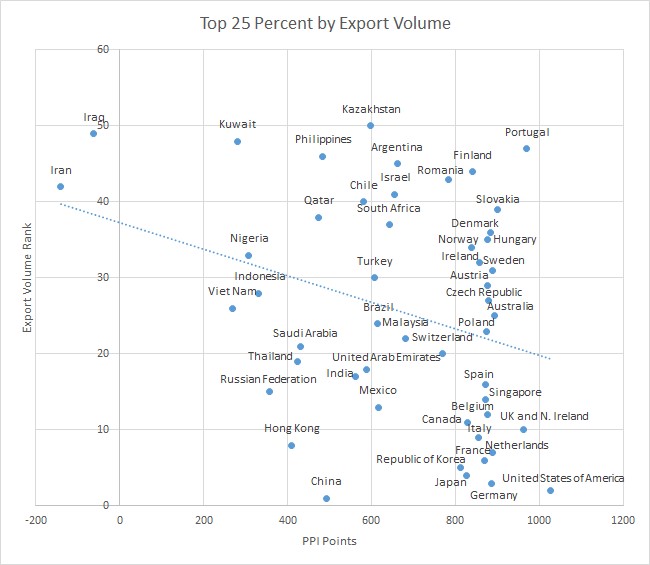
Figure 1. Ranking within the top 25 percent of countries by volume of exports compared to their PPI points. Outliers with a high export volume but low PPI rank can be found towards the mid to upper left.
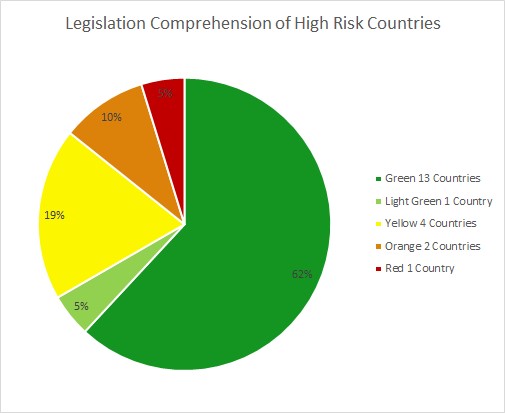
Figure 2. Out of 21 countries with high export volumes and PPI scores of less than half of the total points possible, seven do not have the legal basis for strategic export controls (yellow, orange, and red color-coded legislation). For a detailed legislation color key see Chapter 3 of the PPI report.
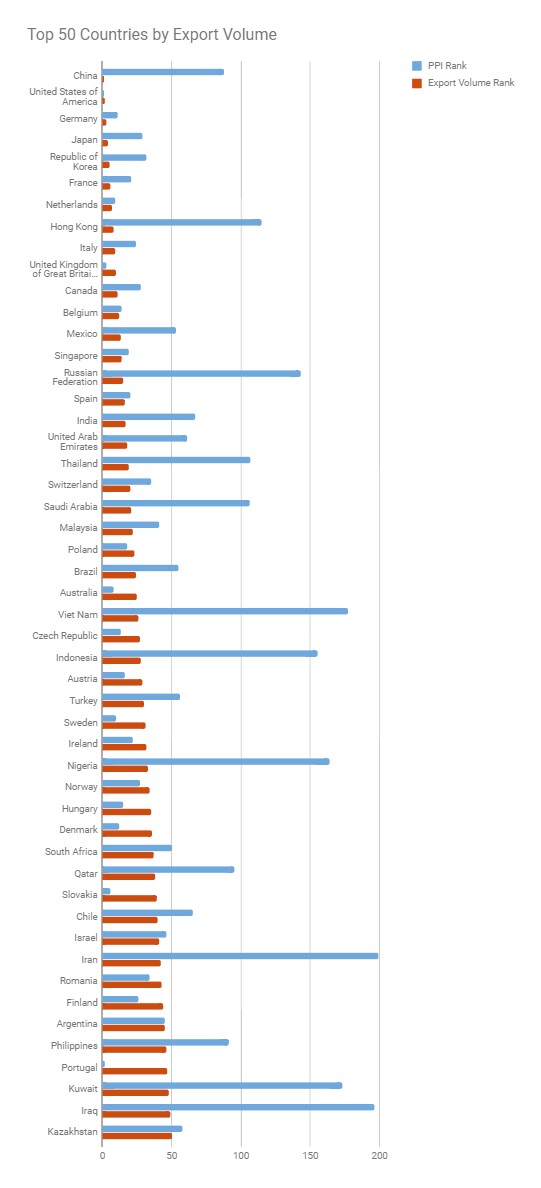
Figure 3. The bar graph compares the PPI ranks and annual export volume ranks of the top 50 countries by export volume. The longer the length of the blue bar, the greater the PPI ranking.
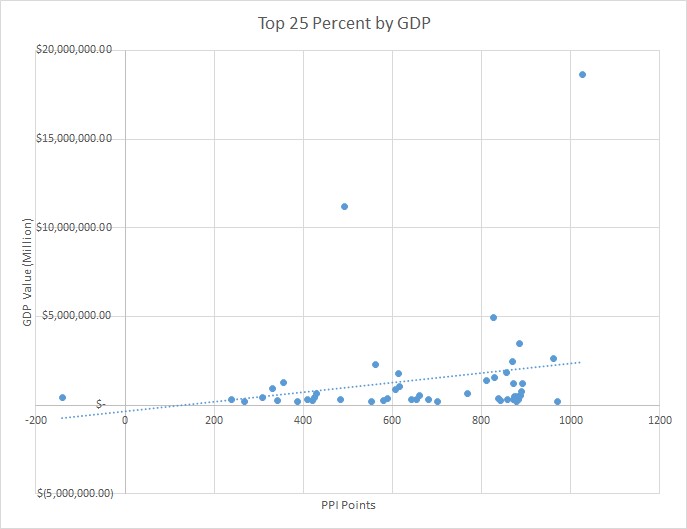
Figure 4. The top 25 percent of countries by GDP compared to their PPI points. There is a slight trend that countries with higher GDP received more points in the PPI.
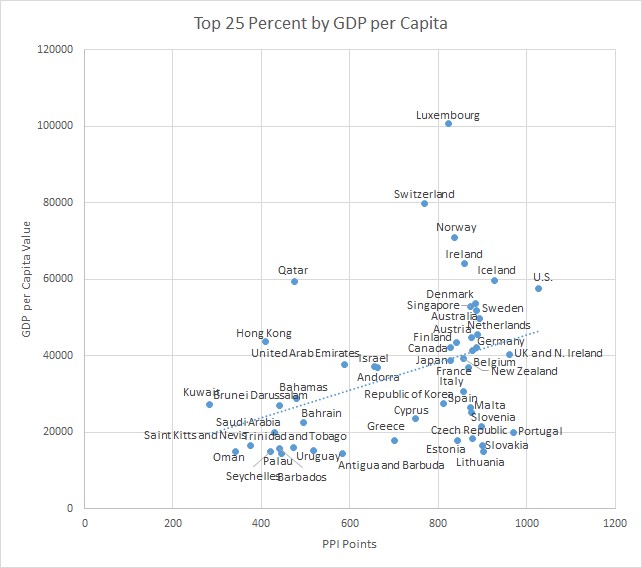
Figure 5. The top 25 percent of countries by GDP per capita compared to their PPI points. The outliers towards the top left have a high GDP per capita but did not receive many PPI points. Outliers in the bottom right could be considered model countries for other countries with low GDP per capita that want to implement or improve national strategic export controls.
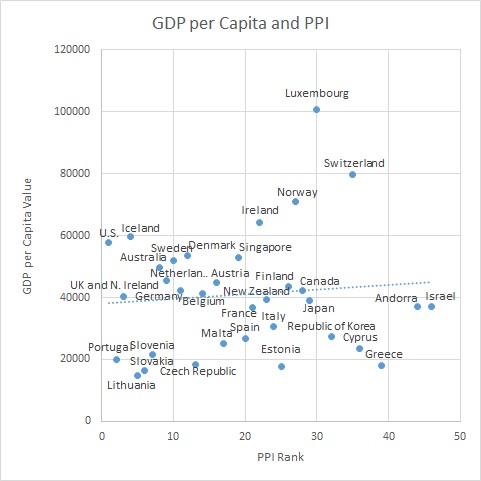
Figure 6. Thirty-four countries fall into the top 25 percent for both GDP per capita and PPI rank.
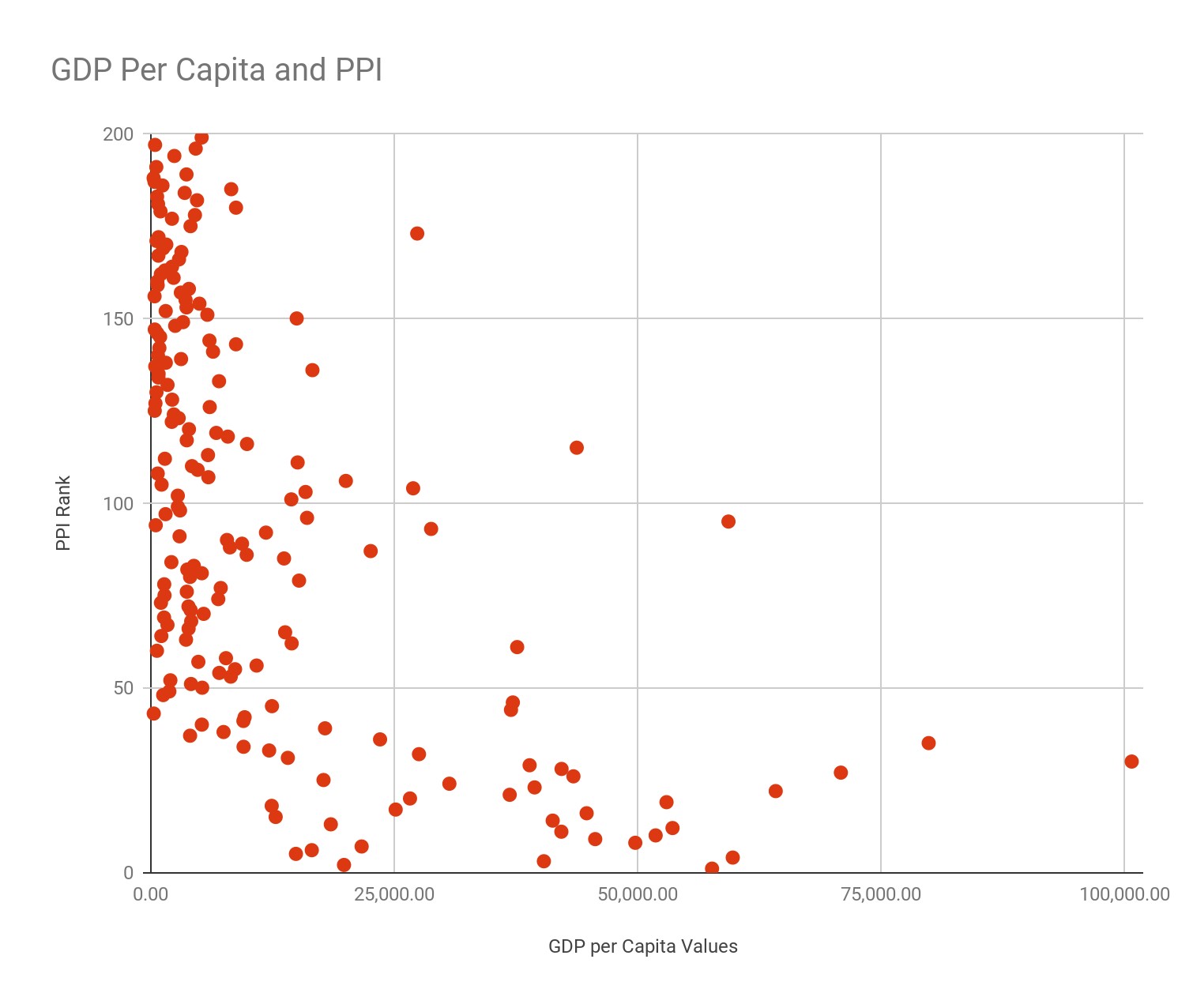
Figure 7. All 200 countries are compared by PPI scores and GDP per capita. The outliers with high GDP per capita but worse PPI ranks are found toward the top right.
1. Albright, Burkhard, Lach, and Stricker, Peddling Peril Index for 2017, Institute for Science and International Security, January 31, 2018, http://isis-online.org/ppi/detail/peddling-peril-index-ppi-2017/↩
2. The World Bank, GDP (Current US$), https://data.worldbank.org/indicator/NY.GDP.MKTP.CD?view=map(Accessed March 2018); United Nations Statistics Division, Annual Totals Table,https://unstats.un.org/unsd/trade/data/tables.asp#annual(Accessed March 2018); World Bank, GDP per Capita (Current US$),https://data.worldbank.org/indicator/NY.GDP.PCAP.CD (Accessed March 2018). The countries or entities with no recorded data by export volume but evaluated by the PPI are: San Marino, Liechtenstein, Monaco, Taiwan, Holy See, and Kosovo. The countries or entities with no recorded data by GDP or GDP per capita but evaluated by the PPI are: Liechtenstein, Monaco, Cuba, Niger, Taiwan, Djibouti, Venezuela (Bolivarian Republic of), Niue, Cook Islands, Holy See, Eritrea, Libya, Syrian Arab Republic, Palestine (State of), South Sudan, and DPRK. ↩
3. Indonesia, Nigeria, Kuwait, Viet Nam, and Iraq are Tier Two countries in the PPI. Tiers One, Two, and Three are defined broadly as suppliers, transshippers, and everyone else, respectively. For Tier Two countries, the PPI considers countries scoring below one third of the total points as needing significant work. For countries in Tier one, which includes Iran in the above list, the equivalent level is one half of the total points for needing significant work.↩
4. Two countries are excluded from the average value. They are San Marino and Liechtenstein. They are excluded because they do not have any recorded export volume data in the sources. In the sources used, the countries are given a value of zero dollars and thus are included in the bottom 25 percent of countries by export volume.↩
5. World Bank, GDP per Capita (Current US$),https://data.worldbank.org/indicator/NY.GDP.PCAP.CD (Accessed March 2018). The countries or entities with no recorded data by GDP per capita but evaluated by the PPI are: Liechtenstein, Monaco, Cuba, Niger, Taiwan, Djibouti, Venezuela (Bolivarian Republic of), Niue, Cook Islands, Holy See, Eritrea, Libya, Syrian Arab Republic, Palestine (State of), South Sudan, and DPRK.↩
6. See chapter 12 of the PPI.↩

 twitter
twitter